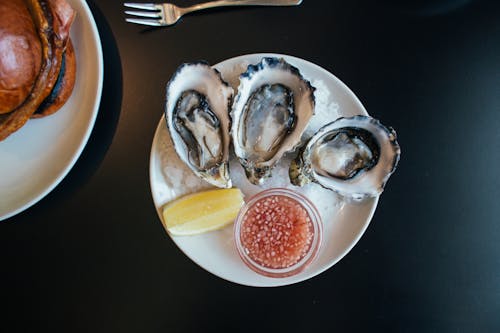Eating foods high in omega 3 is extremely important for your brain health, joint health, skin vitality and overall wellness. An omega 3 deficiency from not consuming enough foods high in omega 3 can cause a variety of problematic symptoms. The symptoms of omega 3 deficiency include brain fog, poor focus and concentration, dry skin, brittle nails, dry hair, fatigue and joint pain.
Omega 3 should be abundant in your diet for optimal wellness. Some healthy fats such as omega 3 fatty acids are critical for your overall well-being. Omega 3 can help reduce inflammation in your body, promote better brain function, and improve the health of your hair, skin and nails. Check out this article on the different types of omega 3 and the various health benefits of omega 3.
Since the only way to consume omega 3 is through our diet, and food is the only way to access it, it’s important to know the best foods high in omega 3. Which foods are richest in the fatty acids you need? Below are some of the best foods high in omega 3 that you could incorporate into your diet. Ensure you’re aware of any food intolerances you might have before you start adding new foods to your diet. From there, you can begin adding these foods high in omega 3 to your grocery list:
1. Chia Seeds
Omega-3 content: 5,060mg per serving
Chia seeds are wonderfully nutritious, and something a lot of people are beginning to add to their diet. You can consume chia seeds in many creative ways. A good dose of chia seeds in your morning smoothie or sprinkled into your granola will give you a healthy amount of omega 3, selenium, manganese, and magnesium.
Many people also make chia seed pudding as a healthy dessert. A standard 1-ounce serving of chia seeds contains around 5 grams of protein, as well as all of the 8 essential amino acids your body needs. One ounce of chia seeds contains 5,060mg of omega 3.
2. Fatty Fish: Mackerel
Omega-3 content: 4,107mg per serving
Mackerel is extremely rich in vital nutrients. This small and fatty fish can contain up to 200% of the recommended daily intake for vitamin B12 with just a 3.5-ounce serving. The same serving would also provide you with 100% of your recommended daily selenium intake and around 4,107mg of omega 3.

3. Salmon
Omega-3 content: 4,123 mg per serving
Another excellent food choice for omega 3 health benefits, salmon is rich in omega 3, vitamin D, selenium, and B vitamins. Salmon is one of the best foods high in omega 3. A healthy dose of salmon in your diet can lower your risk of depression, dementia, heart disease, and other conditions. A small serving of 100 grams of salmon can contain up to 4,123 mg of omega-3.
4. Walnuts
Omega-3 content: 2,570 mg per serving
Walnuts are one of the healthiest superfoods out there. If you want to get more omega 3 into your diet, but you don’t like fish, walnuts are a great choice. Sprinkle walnuts in your salads (they go great with goat cheese) or eat them on their own as part of a trail mix. You can even bake banana bread or other baked goods with walnuts. These tasty nuts are also loaded with copper, manganese, vitamin E, and fibre. It’s worth keeping the skin of the walnut on, if possible, as it contains the highest levels of phenol antioxidants. For omega 3 purposes, walnuts will provide you with around 2,570 mg per ounce.
5. Flax Seeds
Omega-3 content: 2350 mg per serving
Flax seeds are another one of the few non-fish foods high in omega 3. These seeds are frequently ground, milled, and used to make oil. Flax seeds are the highest source of ALA available today. They’re rich in magnesium, fibre, and other nutrients, and have an excellent omega 6 to omega 3 ratio. Around 10 mg of flax seeds offers up to 2,350mg of omega 3 (For the whole seeds).
6. Anchovies
Omega-3 content: 2,113 mg per serving
Anchovies are the oily, miniature fish you’ll sometimes see in sauces or occasionally on a pizza. Anchovies have a strong taste, which means they don’t appeal to everyone. However, these small fish are high in selenium, niacin, and even calcium. A serving of around 100 grams of European anchovies has 2,113 mg of omega 3.

7. Sardines
Omega-3 content: 1,480 mg per serving
Sardines are small, oily fish often eaten as a delicacy or snack. These highly nutritious fish are brimming with vitamin D, vitamin B12, and selenium. Around 100 grams of sardines will serve up a significant 1,480 mg of omega-3.
8. Soybeans
Omega-3 content: 1,241 mg per serving
Soybeans are a great source of protein and fibre. They’re also a good source of nutrients like folate, riboflavin, magnesium, vitamin K, potassium, and more. Keep in mind that soybeans can also be quite high in omega-6 fatty acids, which might not be as beneficial to your health as the omega 3 alternatives.
9. Herring
Omega-3 content: 946 mg per serving
An oily, fatty fish commonly found in Nordic countries, herring is frequently sold as a canned snack. The standard smoked fillet will often contain more than 200% of your recommended daily amount of B12, and vitamin D. Herring also contains up to 946mg of omega 3 for every 100g serving.

10. Oysters
Omega-3 content: 370mg per serving
Easily one of the most nutritious foods out there, oysters not only have omega 3, but also contain more zinc than any other food worldwide. Around 6 raw Eastern oysters contain nearly 300% of the RDI for zinc, as well as almost 600% of the RDI for vitamin B12. Offering about 370mg of Omega 3 in 100 grams, oysters are a fantastic addition to your diet. If you see oysters on the menu at a restaurant, order them as a starter. You’ll be doing your body good.
Where Else Can You Get Omega 3?
Omega 3 fatty acids are only available from dietary food sources. If you don’t like the food options above, there are some alternatives out there. Most of the DHA and EPA omega 3 fatty acids come from seafood, certain animal foods and algae.
The large presence of EPA and DHA in fish and seafood is why the substances are often referred to as “marine omega 3s”. Alternatively, Omega 3 ALA foods commonly include a lot of seeds, nuts, and plant-based foods.
While other food substances might not contain the same high amounts of omega 3 as the foods listed above and may not be as rich in omega 3, you can still find some products “enhanced” with omega-3. You might have seen meats, dairy products and eggs in the supermarket with product labels that advertise their enhancement with omega 3.
Getting the Right Amount of Omega 3
Omega 3 is a valuable fatty acid with many health benefits, and something many of us needs to consider more when planning our meals and grocery lists. It’s easy enough to obtain omega 3 from the right food sources.
In general, knowing your optimal diet type and how your body absorbs nutrients is helpful. A DNA test from CircleDNA will inform you of the optimal diet for you based on your DNA, as well as which vital nutrients you have higher needs of.






Comments are closed.